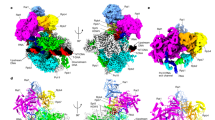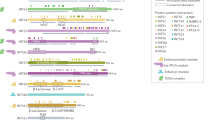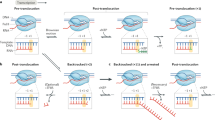Abstract
The carboxy-terminal domain (CTD) of the RNA polymerase II (RNApII) largest subunit consists of multiple heptapeptide repeats with the consensus sequence YSPTSPS. Different CTD phosphorylation patterns act as recognition sites for the binding of various messenger RNA processing factors, thereby coupling transcription and mRNA processing1. Polyadenylation factors are co-transcriptionally recruited by phosphorylation of CTD serine 2 (ref. 2) and these factors are also required for transcription termination3,4. RNApII transcribes past the poly(A) site, the RNA is cleaved by the polyadenylation machinery, and the RNA downstream of the cleavage site is degraded. Here we show that Rtt103 and the Rat1/Rai1 5′ → 3′ exonuclease are localized at 3′ ends of protein coding genes. In rat1-1 or rai1Δ cells, RNA 3′ to polyadenylation sites is greatly stabilized and termination defects are seen at many genes. These findings support a model in which poly(A) site cleavage and subsequent degradation of the 3′-downstream RNA by Rat1 trigger transcription termination5,6.
This is a preview of subscription content, access via your institution
Access options
Subscribe to this journal
Receive 51 print issues and online access
$199.00 per year
only $3.90 per issue
Buy this article
- Purchase on Springer Link
- Instant access to full article PDF
Prices may be subject to local taxes which are calculated during checkout




Similar content being viewed by others
References
Buratowski, S. The CTD code. Nature Struct. Biol. 10, 679–680 (2003)
Ahn, S. H., Kim, M. & Buratowski, S. Phosphorylation of serine 2 within the RNA polymerase II C-terminal domain couples transcription and 3′ end processing. Mol. Cell 13, 67–76 (2004)
Birse, C. E., Minvielle-Sebastia, L., Lee, B. A., Keller, W. & Proudfoot, N. J. Coupling termination of transcription to messenger RNA maturation in yeast. Science 280, 298–301 (1998)
Kim, M., Ahn, S. H., Krogan, N. J., Greenblatt, J. F. & Buratowski, S. Transitions in RNA polymerase II elongation complexes at the 3′ ends of genes. EMBO J. 23, 354–364 (2004)
Connelly, S. & Manley, J. L. A CCAAT box sequence in the adenovirus major late promoter functions as part of an RNA polymerase II termination signal. Cell 57, 561–571 (1989)
Proudfoot, N. J. How RNA polymerase II terminates transcription in higher eukaryotes. Trends Biochem. Sci. 14, 105–110 (1989)
Scholes, D. T., Banerjee, M., Bowen, B. & Curcio, M. J. Multiple regulators of Ty1 transposition in Saccharomyces cerevisiae have conserved roles in genome maintenance. Genetics 159, 1449–1465 (2001)
Doerks, T., Copley, R. R., Schultz, J., Ponting, C. P. & Bork, P. Systematic identification of novel protein domain families associated with nuclear functions. Genome Res. 12, 47–56 (2002)
Meinhart, A. & Cramer, P. Recognition of RNA polymerase II carboxy-terminal domain by 3′-RNA-processing factors. Nature 430, 223–226 (2004)
Tong, A. H. et al. Systematic genetic analysis with ordered arrays of yeast deletion mutants. Science 294, 2364–2368 (2001)
Sterner, D. E., Lee, J. M., Hardin, S. E. & Greenleaf, A. L. The yeast carboxyl-terminal repeat domain kinase CTDK-I is a divergent cyclin-cyclin-dependent kinase complex. Mol. Cell. Biol. 15, 5716–5724 (1995)
Skaar, D. A. & Greenleaf, A. L. The RNA polymerase II CTD kinase CTDK-I affects pre-mRNA 3′ cleavage/polyadenylation through the processing component Pti1p. Mol. Cell 10, 1429–1439 (2002)
Dheur, S. et al. Pti1p and Ref2p found in association with the mRNA 3′ end formation complex direct snoRNA maturation. EMBO J. 22, 2831–2840 (2003)
Nedea, E. et al. Organization and function of APT, a subcomplex of the yeast cleavage and polyadenylation factor involved in the formation of mRNA and small nucleolar RNA 3′-ends. J. Biol. Chem. 278, 33000–33010 (2003)
Petfalski, E., Dandekar, T., Henry, Y. & Tollervey, D. Processing of the precursors to small nucleolar RNAs and rRNAs requires common components. Mol. Cell. Biol. 18, 1181–1189 (1998)
Qu, L. H. et al. Seven novel methylation guide small nucleolar RNAs are processed from a common polycistronic transcript by Rat1p and RNase III in yeast. Mol. Cell. Biol. 19, 1144–1158 (1999)
Xue, Y. et al. Saccharomyces cerevisiae RAI1 (YGL246c) is homologous to human DOM3Z and encodes a protein that binds the nuclear exoribonuclease Rat1p. Mol. Cell. Biol. 20, 4006–4015 (2000)
Amberg, D. C., Goldstein, A. L. & Cole, C. N. Isolation and characterization of RAT1: an essential gene of Saccharomyces cerevisiae required for the efficient nucleocytoplasmic trafficking of mRNA. Genes Dev. 6, 1173–1189 (1992)
Hammell, C. M. et al. Coupling of termination, 3′ processing, and mRNA export. Mol. Cell. Biol. 22, 6441–6457 (2002)
Vasudevan, S. & Peltz, S. W. Nuclear mRNA surveillance. Curr. Opin. Cell Biol. 15, 332–337 (2003)
Bousquet-Antonelli, C., Presutti, C. & Tollervey, D. Identification of a regulated pathway for nuclear pre-mRNA turnover. Cell 102, 765–775 (2000)
Das, B., Butler, J. S. & Sherman, F. Degradation of normal mRNA in the nucleus of Saccharomyces cerevisiae. Mol. Cell. Biol. 23, 5502–5515 (2003)
Yonaha, M. & Proudfoot, N. J. Transcriptional termination and coupled polyadenylation in vitro. EMBO J. 19, 3770–3777 (2000)
Holstege, F. C. et al. Dissecting the regulatory circuitry of a eukaryotic genome. Cell 95, 717–728 (1998)
Solinger, J. A., Pascolini, D. & Heyer, W. D. Active-site mutations in the Xrn1p exoribonuclease of Saccharomyces cerevisiae reveal a specific role in meiosis. Mol. Cell. Biol. 19, 5930–5942 (1999)
Ujvari, A., Pal, M. & Luse, D. S. RNA polymerase II transcription complexes may become arrested if the nascent RNA is shortened to less than 50 nucleotides. J. Biol. Chem. 277, 32527–32537 (2002)
West, S., Gromak, N. & Proudfoot, N. Human 5′ → 3′ exonuclease XRN2 promotes transcription termination from co-transcriptional cleavage sites. Nature doi:10.1038/nature03035 (this issue)
Krogan, N. J. et al. RNA polymerase II elongation factors of Saccharomyces cerevisiae: a targeted proteomics approach. Mol. Cell. Biol. 22, 6979–6992 (2002)
Zhao, J., Kessler, M., Helmling, S., O'Connor, J. P. & Moore, C. Pta1, a component of yeast CF II, is required for both cleavage and poly(A) addition of mRNA precursor. Mol. Cell. Biol. 19, 7733–7740 (1999)
Lashkari, D. A. et al. Yeast microarrays for genome wide parallel genetic and gene expression analysis. Proc. Natl Acad. Sci. USA 94, 13057–13062 (1997)
Acknowledgements
We thank C. Moore and her laboratory for advice on polyadenylation reactions; N. Proudfoot, S. McCracken and B. Blencowe for sharing unpublished information; and the Taplin Mass Spectroscopy facility at Harvard Medical School and D. Richards of Affinium Pharmaceuticals for mass spectroscopy. N.J.K. was supported by a Doctoral Fellowship from the Canadian Institutes of Health Research (CIHR). O.J.R. is supported by funding from the Bauer Center for Genomics Research. This research was supported by grants to S.B. from the US National Institutes of Health, and to J.F.G. from the Canadian Institutes of Health Research, the Ontario Genomics Institute, and the National Cancer Institute of Canada with funds from the Canadian Cancer Society. L.V. is a Fellow and S.B. is a Scholar of the Leukemia and Lymphoma Society.Authors’ contributions All authors contributed to the conception and design of the experiments. M.K. performed the CTD affinity purification of Rtt103, RT–PCR analysis, ChIP analyses and Rat1 mutagenesis. N.K. did the Rtt103-TAP purification and the SGA analysis. L.V. conducted the immunoblotting, exonuclease and polyadenylation assays. E.N. performed the Pcf11 and Rna15 TAP purifications. The microarray experiments were done by M.K. and O.J.R. The paper was written by M.K., J.G. and S.B. with input from the other authors.
Author information
Authors and Affiliations
Corresponding author
Ethics declarations
Competing interests
The authors declare that they have no competing financial interests.
Supplementary information
Supplementary Figures 1 and 2
Fig 1: The termination defect in the rat1-1 mutant is not due to protein instability or defects in polyadenylation; Fig 2: The Rat1 D235A mutant lacks exonuclease activity. (DOC 81 kb)
Supplementary Table 1
The Rat1 D235A mutant lacks exonuclease activity. (DOC 26 kb)
Rights and permissions
About this article
Cite this article
Kim, M., Krogan, N., Vasiljeva, L. et al. The yeast Rat1 exonuclease promotes transcription termination by RNA polymerase II. Nature 432, 517–522 (2004). https://doi.org/10.1038/nature03041
Received:
Accepted:
Issue Date:
DOI: https://doi.org/10.1038/nature03041
This article is cited by
-
Ceg1 depletion reveals mechanisms governing degradation of non-capped RNAs in Saccharomyces cerevisiae
Communications Biology (2023)
-
Hydroxyurea and inactivation of checkpoint kinase MEC1 inhibit transcription termination and pre-mRNA cleavage at polyadenylation sites in budding yeast
Scientific Reports (2023)
-
Observation of conformational changes that underlie the catalytic cycle of Xrn2
Nature Chemical Biology (2022)
-
Structural insights into nuclear transcription by eukaryotic DNA-dependent RNA polymerases
Nature Reviews Molecular Cell Biology (2022)
-
Current understanding of CREPT and p15RS, carboxy-terminal domain (CTD)-interacting proteins, in human cancers
Oncogene (2021)
Comments
By submitting a comment you agree to abide by our Terms and Community Guidelines. If you find something abusive or that does not comply with our terms or guidelines please flag it as inappropriate.



